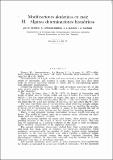Por favor, use este identificador para citar o enlazar a este item:
http://hdl.handle.net/10261/21572COMPARTIR / EXPORTAR:
 SHARE
BASE SHARE
BASE
|
|
| Visualizar otros formatos: MARC | Dublin Core | RDF | ORE | MODS | METS | DIDL | DATACITE | |

| Título: | Modificaciones alotácticas en maíz. III. Algunas determinaciones biométricas |
Autor: | Blanco González, Mariano; Lorenzo Andreu, Antonio CSIC; Blanco González, José Luis; Álvarez Rodríguez, Ángel CSIC | Fecha de publicación: | 1975 | Editor: | CSIC - Estación Experimental de Aula Dei (EEAD) | Citación: | An. Estac. Exp. Aula Dei 13 (1/2):98-110 (1975) | Resumen: | [EN] Determinations of length, width and area of leaves, height of plant and length of internodes, and number of nodes, leaves, and ears, have been made in normal distichous plants of maize and in correponding plants with allotactic modifications. Comparing decussate material (De) with distichous material (Di) of the same genetic origin, the ratio De/Di results in different values depending on the character. The ratio is lower than 1, De/Di = 0,75, for length of internodes and height of plant, and for length, width, and area of leaves. The ratido is near 1 (De/Di = 1.01) for mean number of nodes. The ratio is higher than 1, for the features total blade area per plant (De/Di = 1.28), total number of leaves per plant (De/Di = 2.03) and number of potential ears per plant (DE/Di = 3.21). The total leaf blade area of the distichous plant receiving sunlight energy, might be genetically increased through decussation, by doubling the number of leaves, or by increasing the number of nodes, or by growing the size of the leaf. Each and every option may be choiced for breeding purposes. There is and apparent positive correlation between length and area of leaves. The width of leaves tends to a constant value, different for distichous and for decussate material. With increasing number of nodes and leaves, there follows a corresponding decrease of the length of leaves and the area of leaves. This fact may be considered as a natural tendency of the plant to hold its physiological stability irrespective of its apparent phenotype. The normal distichous phenotypes studied here, have a practically constant total leaf blade area. In contrast, the decussate phenotypes, while positively correlated with the number of nodes, present rather important variability in the total leaf blade area, which signifies a different capability for trapping sunlight energy. One might conclude, therefore, that physiological stability for decussate material may be reached at a level different from that of distichous material. The normal distichous plant seems to have reached its best equilibrium for height, as indicated by a constan length of internodes. Yet the decussate plant seems to be potentially operative, as indicated by the variable length of internodes. The distichous phenotype with opposite leaves, has a potentiality similar to decussate plants. The different behaviour of phenotypes is displayed in the first stages of the living plant, at least as far as the current increase of the number of leaves is concerned. However, some detective characters dealing with shortness of the stem, are not expressed until more advanced developmental stages have been reached. | URI: | http://hdl.handle.net/10261/21572 | ISSN: | 0365-1800 |
| Aparece en las colecciones: | (EEAD) Artículos |
Ficheros en este ítem:
| Fichero | Descripción | Tamaño | Formato | |
|---|---|---|---|---|
| VOL. 13 Nº1-2Blanco,Lorenzo-Andreu.pdf | 616,94 kB | Adobe PDF |  Visualizar/Abrir |
CORE Recommender
Page view(s)
316
checked on 05-may-2024
Download(s)
92
checked on 05-may-2024
Google ScholarTM
Check
NOTA: Los ítems de Digital.CSIC están protegidos por copyright, con todos los derechos reservados, a menos que se indique lo contrario.
